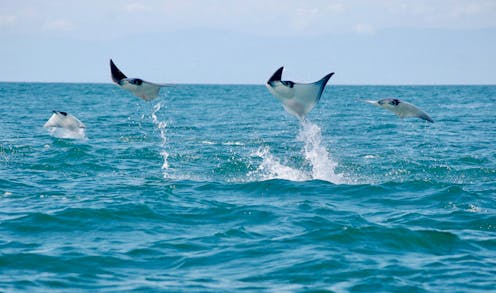
Manta rays breaching in waters off Costa Rica. Peter Loring, iStock/Getty Images
Many sharks and rays are known to breach, leaping fully or partly out of the water. In a recent study, colleagues and I reviewed research on breaching and ranked the most commonly hypothesized functions for it.
We found that removal of external parasites was the most frequently proposed explanation, followed by predators chasing their prey; predators concentrating or stunning their prey; males chasing females during courtship; and animals fleeing predators, such as a ray escaping from a hammerhead shark in shallow water.
We found that the highest percentage of breaches, measured by the number of studies that described it, occurred in manta rays and devil rays, followed by basking sharks and then by eagle rays and cownose rays. However, many other species of sharks, as well as sawfishes and stingrays, also perform this behavior.
A breaching white shark surprises researchers off Cape Cod, Massachusetts.
Why it matters
It takes a lot of energy for a shark or ray to leap out of the water – especially a massive creature like a basking shark, which can grow up to 40 feet (12 meters) and weigh up to 5 tons (4.5 tonnes). Since the animal could use that energy for feeding or mating, breaching must serve some useful purpose.
Sharks that have been observed breaching include fast-swimming predatory species such as blacktip sharks and blue sharks. White sharks have been seen breaching while capturing seals in waters off South Africa and around the Farallon Islands off central California.
However, basking sharks – enormous, slow-swimming sharks that feed by filtering tiny plankton from seawater – also breach. So do many ray species, such as manta rays, which also are primarily filter feeders. This suggests that breaching likely serves different functions among different types of sharks and rays.
The most commonly proposed explanation for breaching in planktivores, like basking sharks and most rays, is that it helps dislodge parasites attached to their bodies. Basking sharks are known to host parasites, including common remoras and sea lampreys. The presence of fresh wounds on basking sharks that match the shape and size of a lamprey’s mouth suggests that breaching has torn the lampreys off the sharks’ bodies.
Basking sharks are filter feeders that live on plankton. They may breach to rid their bodies of parasites.
Other species may breach to communicate. For example, white sharks propelling themselves out of the water near the Farallon Islands may do so to deter other sharks from feeding upon the carcass of a seal.
Researchers have seen large groups of mantas and devil rays jumping together among dense schools of plankton – presumably to concentrate or stun the plankton so the rays can more easily scoop them up. Scientists have also suggested that planktivorous sharks and rays may breach to clear the prey-filtering structures in their gills.
Understanding more clearly when and how different types of sharks and rays breach can provide insights into these animals’ life habits, and into their interactions with their own species and competitors.
How we did our work
I worked with marine scientists Tobey Curtis, Emmett Johnston, Alison Kock and Guy Stevens. Across our various projects, we have seen breaching in bull sharks in Florida, basking sharks in Ireland, white sharks in South Africa and central California, and manta rays in the Maldives. Each of us has proposed different explanations for why the animals did it.
We reviewed scientific studies and video footage to see what species had been observed to breach, under what conditions, and the functions that other researchers had proposed for them doing so. This included information gathered from data logging tags attached to sharks and rays, digital photography, and imagery from underwater and aerial drones.
Our review proposes further studies that could provide more information about breaching in different species. For example, attaching data loggers to individual animals would help scientists measure how quickly a shark or ray accelerates as it propels itself out of the water.
Experiments in aquarium tanks could provide more insight into why the animals breach. For example, scientists could add remoras to a tank containing bull sharks, which can live in an aquarium environment, and observe how the sharks respond when remoras attach themselves to the sharks’ bodies.
In the field, researchers could play audio recordings of splashes from breaches to elicit withdrawal or attraction responses from sharks tagged with ultrasonic transmitters. There remains much to learn about why these animals spend precious energy jumping out of the water.
The Research Brief is a short take on interesting academic work.
A. Peter Klimley does not work for, consult, own shares in or receive funding from any company or organization that would benefit from this article, and has disclosed no relevant affiliations beyond their academic appointment.
Advertisement

Advertisement
Contact Us
If you would like to place dofollow backlinks in our website or paid content reach out to info@qhubonews.com











